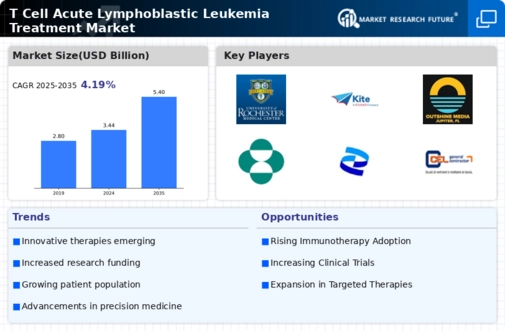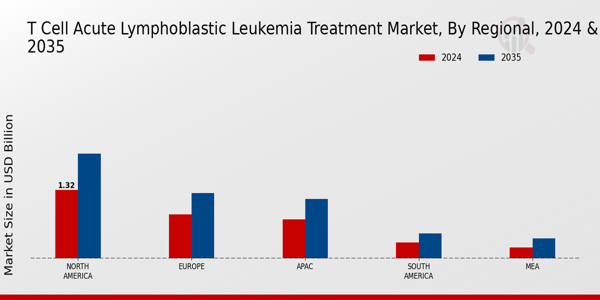Advancements in Targeted Therapies
Innovations in targeted therapies are transforming the landscape of the Global T Cell Acute Lymphoblastic Leukemia Treatment Market Industry. Therapies such as CAR T-cell therapy have shown promising results in clinical trials, leading to improved patient outcomes. These advancements not only enhance treatment efficacy but also reduce the side effects associated with traditional chemotherapy. As a result, the market is expected to grow significantly, with projections indicating a value of 5.4 USD Billion by 2035. This growth underscores the importance of continued research and development in targeted treatment modalities.
Market Trends and Growth Projections
The Global T Cell Acute Lymphoblastic Leukemia Treatment Market Industry is characterized by various trends and growth projections. The market is anticipated to reach 3.44 USD Billion in 2024, with a steady increase expected to 5.4 USD Billion by 2035. The compound annual growth rate (CAGR) of 4.18% from 2025 to 2035 indicates a positive outlook for the industry, driven by advancements in treatment modalities and increasing patient awareness. This growth trajectory reflects the ongoing commitment to improving outcomes for patients diagnosed with T-ALL.
Growing Awareness and Early Diagnosis
Rising awareness about T Cell Acute Lymphoblastic Leukemia is fostering early diagnosis and treatment, which is a significant driver for the Global T Cell Acute Lymphoblastic Leukemia Treatment Market Industry. Educational campaigns and improved screening methods are enabling healthcare professionals to identify the disease at earlier stages. Early intervention is crucial for better patient outcomes, which in turn drives demand for effective treatment options. As awareness continues to grow, the market is likely to expand, reflecting the critical role of timely diagnosis in managing T-ALL.
Increased Investment in Cancer Research
The Global T Cell Acute Lymphoblastic Leukemia Treatment Market Industry benefits from heightened investment in cancer research. Governments and private organizations are allocating substantial funds to explore novel treatment approaches, including immunotherapy and gene editing technologies. This influx of capital is likely to accelerate the pace of innovation, leading to the introduction of new therapies that could improve survival rates. With a projected compound annual growth rate (CAGR) of 4.18% from 2025 to 2035, the market is poised for sustained growth as research initiatives continue to evolve.
Regulatory Support for Innovative Treatments
Regulatory bodies are increasingly supporting the development of innovative treatments for T Cell Acute Lymphoblastic Leukemia, which serves as a vital driver for the Global T Cell Acute Lymphoblastic Leukemia Treatment Market Industry. Initiatives such as expedited approval processes for breakthrough therapies are encouraging pharmaceutical companies to invest in research and development. This regulatory environment not only facilitates quicker access to new treatments for patients but also stimulates market growth. As a result, the industry is expected to experience a robust expansion trajectory in the coming years.
Rising Incidence of T Cell Acute Lymphoblastic Leukemia
The increasing prevalence of T Cell Acute Lymphoblastic Leukemia (T-ALL) is a critical driver for the Global T Cell Acute Lymphoblastic Leukemia Treatment Market Industry. Data indicates that the incidence rate is on the rise, particularly among adolescents and young adults. This trend necessitates the development of effective treatment options, thereby expanding the market. As healthcare systems worldwide adapt to this growing challenge, the market is projected to reach 3.44 USD Billion in 2024, reflecting a heightened demand for innovative therapies and supportive care solutions.

























Leave a Comment